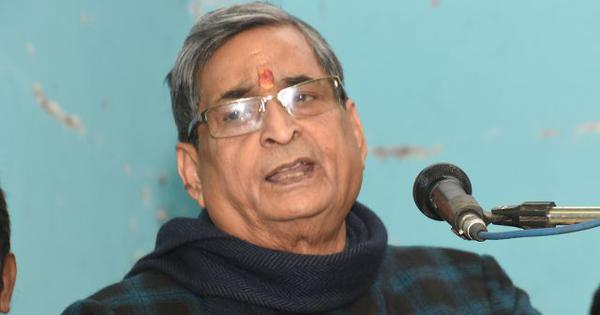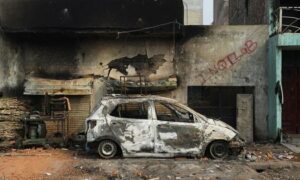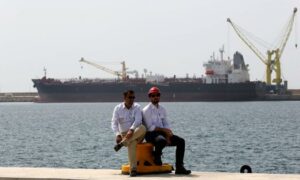
After the success of Indian IT behemoth Infosys and American social media giant Facebook, and recent startups like Zomato and Ather, it has become a norm to celebrate businesses that started off from garages or modest one-room operations. The beginnings of SIS were similar.
In the first few years of its life, SIS’s address was 94, Patliputra, Patna. Officially, this was the residence of Ravindra Kishore. But for all practical purposes, it was also his office. He lived upstairs on the first floor with his family, including his parents. Downstairs were two rooms that became SIS’s office. If there were too many people to accommodate, the veranda would become the office’s extension. On the back there was a garage, which in later years would hold a kennel for dogs that were trained and deployed on customer sites.
On Sundays, 94, Patliputra would become a recruitment centre. The house had a lawn that would be filled with a steady stream of youngsters hoping to land a job. They would fill up their forms and wait for instructions from UN Singh, one of Ravindra Kishore’s earliest hires. On his instruction, the young men would stand in a queue and their height and weight would be measured. Each candidate needed to be at least 5’7” tall and weigh a maximum of 70 kg. A physical test would be done.
Once a candidate cleared these rounds, he would be asked to go inside one of the two rooms on the ground floor for the interview. The interview panel was headed by Ravindra Kishore himself. Accompanying him would be retired army generals, senior bureaucrats and police officers. Once selected, a candidate would be given a kit that included his uniform. He would have to report for training for a month and then be deputed to a customer site.
Some of SIS’s senior-most executives of today started their careers from that very lawn. This includes Arvind Prasad who would go on to become the chief financial officer, Vinaya Srivastawa, the future chief executive officer and AK Singh, who would head multiple ancillary ventures. Not all of them started off as security guards. Arvind Prasad was in the accounts department, Srivastawa in stores. But all of them attended job interviews and got their offer letters right there.
The line separating home from office was blurred. At meal times, whoever was present, be it employee or client, would sit down with the Sinhas to have food. More often than not, Rita, Ravindra Kishore’s wife, would be in the middle of preparations when an employee came with a message: “Sir is coming with six people. They will also have lunch.” How does one manage to feed twenty people if the food was being cooked for only twelve or fourteen? Was it possible to quickly cook more? If not, what adjustment could be done? For Rituraj, and later his sister Rivoli, the first lessons of people management probably were learnt right from the kitchen of their home.
As the family held the fort at home, Ravindra Kishore focused on the business. He had taken the entrepreneurial plunge with the security business. To grow it, the business needed a push and a shove as often as possible. In the first few years, Hari Budhia’s Bihar Foundry remained SIS’s biggest customer. It became Ravindra Kishore’s own training ground even as the industrial landscape of Bihar in the 1970s evolved, throwing up opportunities for a startup like SIS.
Erstwhile Bihar is a state of paradox. It was naturally gifted. It had coal, iron ore, bauxite, limestone and several other minerals (many of these mineral-rich regions are now part of Jharkhand which was carved out of Bihar in 2000). This is what had led Jamsetji Tata, the founder of Tata Group, to come to Bihar in search of iron ore and set up Tata Iron and Steel Company (TISCO), better known today as Tata Steel. That was in 1907. Jamshedpur, the company’s headquarters, became one of the first industrial hubs in the whole of India. The city is also an example of a modern planned urban place, with better civic amenities than most of the other cities in this part of the country.
Going by Bihar’s immense natural bounty, the state should have had many Jamshedpurs by the late 1970s when Ravindra Kishore set up SIS. To be fair, it did attract the likes of Hari Budhia. The Ramgarh belt had huge deposits of coal, one of the two critical ingredients along with iron ore used to make steel. Many more companies, like Bihar Foundry, came up in Ramgarh’s industrial area. Similarly, aspiring entrepreneurs like Budhia also set up cement companies to exploit the rich limestone deposits in the region.
Yet, they had a problem: labour trouble. Tata Steel had a long history of tussles between its management and the labour union. Budhia also faced a similar problem at the Bihar Foundry. A manufacturing facility like this involved movement of different kinds of raw materials and products, either transported from mines or being shipped to customers. These moved in trucks in and out of the premises. Security was needed in nearly every part of this movement – at mines, gates and where the loading and unloading of materials took place. These industrial units employed hundreds or even thousands of labourers, mostly on contract. Supervising them and their movement – these were days before security cameras and drones – was a difficult job. Unions made the job of supervising even more difficult. While it would be unfair to characterise all labour unions with the same brush, it was not uncommon for unions to develop links with local mafias or enjoy political patronage. Company owners and their management would hesitate to directly intervene when cases of pilferage cropped up, fearing an industrial unrest by the unions that would have an even worse impact on operations than the theft itself. Owners like Budhia depended on their security personnel to keep an eye on the movement of manpower and material, and also the other on the unions.
Security came in the form of a chowkidar and a darbaan. They had little to no training. This meant they didn’t understand the demands of the job. Worse, many couldn’t read and write properly, a requirement to check documents at entry and exit gates. Were they trained to take on the physical demands of the job, including facing off with unwanted elements? Rarely. Worse, in many instances, these very security personnel would join hands with the unions. This would make the union and their leaders even more powerful.
With no respite, businessmen would approach politicians who had clout and influence with the unions and local police. As we know, those who approached JP for help were directed to Ravindra Kishore. In SIS, Ravindra Kishore had the opportunity to change how the security manpower business worked. Listening to Budhia and the problems he was facing, Ravindra Kishore understood the requirements: bold and honest security personnel who could read and write, were fit physically and were trained to understand and address their client’s needs.
Ravindra Kishore found the solution in the resources that were available – retired army officers and soldiers. These ex-servicemen were the only ones who had exposure to a life in uniform and work experience that centred around security. “They were disciplined, followed commands and were aggressive,” says Vinaya Srivastawa. They also became officers, supervisors and trainers. Among the most influential ones in those early days was UN Singh. He had retired as a subedar from the army, and Ravindra Kishore made him SIS’s first officer in the manager rank. Singh had a registration number of 5001 – all officers in the company had their numbers starting with 5. He was not posted to a specific site but managed people, planned recruitment and training and even sanctioned leaves.
Like ex-servicemen, Ravindra Kishore also roped in retired police officers and bureaucrats. Retired police officers, like army veterans, had also led a life in uniform and specialised in providing security. They responded well to training, and again, understood recruitment. These police officers, like bureaucrats, had another attraction. They had influence with local administrations and former colleagues at the police and government departments.
The bureaucrats, army and police officers also came with years of experience in administration. As brigadiers, heads of government departments or as superintendents of a city, these professionals had managed people, budgets and offices. They knew how things worked. Ravindra Kishore, a young entrepreneur, grew to understand the importance of systems from them. And they were the ones to set up SIS’s first systems and processes. Quickly, Ravindra Kishore developed a flair for it. If anyone suggested a new practice or method, Ravindra Kishore was quick to understand if it would work or not. If it did, he was equally swift in implementing these in SIS.
Excerpted with permission from The SIS Story: How an Accidental Entrepreneur From Bihar Created a Global Services Conglomerate, Prince Mathews Thomas, HarperCollins India.
📰 Crime Today News is proudly sponsored by DRYFRUIT & CO – A Brand by eFabby Global LLC
Design & Developed by Yes Mom Hosting






